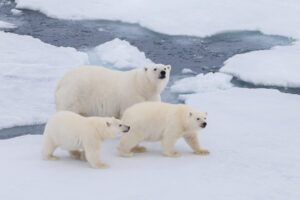Media & news

What About the Bears?
Dec 3, 2024
I have written several articles over the past few months about the climate nonsense promoted by activists to convince the public that immediate action is required to prevent catastrophic damage to the planet. This month, I will review an article, written by Bjorn Lomborg, published in the Wall Street Journal on July 31, 2024. Mr. Lomborg is president of the Copenhagen Consensus and a visiting fellow at Stanford University’s Hoover Institution. He is an economist and not a scientist.
Mr. Lomborg asks why the hype about climate change killing polar bears stopped. Al Gore in his 2007 documentary, An Inconvenient Truth, was one of the first climate activists to use scare tactics to warn that immediate action was necessary to reduce carbon dioxide emissions or polar bears would soon be extinct. In the documentary, a polar bear is shown on a very small iceberg floating off into the distance as the commentator explains that polar bears will drown when the icebergs melt because of climate change. As early as 2004, The Washington Post warned that polar bears could face extinction, and The World Wildlife Fund’s Chief Scientist claimed that some polar bears would stop reproducing by 2012.
Then, about a decade ago, the hype about polar bears stopped. After years of warnings and scientific predictions, activists recognized that the polar bear populations were not declining but instead growing, substantially, from approximately 12,000 in the 1960s to about 26,000 today. Apparently, polar bears are very adaptive, or the science was wrong. However, you can still adopt a polar bear with the World Wildlife Fund for $25 to $250 and receive a certificate of adoption, a gift box, a frame and picture of your polar bear, and a plush stuffed polar bear.
Just like the polar bears, climate activists warned that Australia’s Great Barrier Reef would be killed by rising sea temperatures. After the reef was damaged by a hurricane in 2009, the percentage of the reef that was covered in coral dropped to a record low, and the media and scientists predicted the reef coral cover would be halved again by 2022. The Guardian even published an obituary for the reef in 2014.
However, the latest measurements show that the Great Barrier Reef has more coral cover than at any time since 1986 when coral cover monitoring began. A new record was set in 2024. Apparently, the reef is much more adaptive than anticipated, or the science was wrong. You can adopt (apparently co-adopt) the Great Barrier Reef for $150, although you don’t get a plush stuffed toy.
Scientists also warned that small islands in the Pacific would disappear as sea levels rose. In 2019, U.N. Secretary-General and climate activist, Antonio Guterres, had his picture taken standing thigh-deep off Tuvalu, in the South Pacific, for a cover shot for a Time magazine story, Our Sinking Planet.
However, this summer, The New York Times shared surprising climate news that almost all atoll islands are stable or increasing in size. While rising sea levels erode the islands, additional sand is washed up, increasing low-lying shores. Studies have shown that for a decade the deposits of new sand have outpaced the climate erosion of the island shores. However, you didn’t see any publicity on the growth of low-lying islands until this year. Science may have been wrong again. As far as I can find, you can’t adopt a Pacific low-lying island. The islands are leaving money on the table.
And speaking of incorrect facts, President Biden recently declared, “extreme heat is the number one weather-related killer in the U.S.” It isn’t clear whether his statement was based on science, but it is wrong by a factor of about 15 to 20 times. Extreme heat kills about 6,000 Americans every year and another 4,000 deaths are associated with moderate heat exposure. However, extreme cold kills about 150,000 Americans annually. Age-standardized extreme heat deaths have declined in the U.S. by almost 10% a year mainly because more people obtain access to air conditioning and heat as they become more affluent and have better quality of life.
All the climate activists’ warnings are intentional to illogically skew the climate change discussion. After all, eliminating fossil fuels will not be easy or cheap. People will become poorer and their lives will be more difficult without fossil fuels. Activists understand that the use of fossil fuels must be shown as catastrophic, or people won’t be willing to make the change. Thus, the exaggerated claims of climate damage.
Mr. Lomborg sums up his article by stating that more than $2 trillion is spent across the globe every year on climate policies and programs – far more than the damage those policies are designed to prevent would cost. He says, “Telling half-truths while piously pretending to “follow the science” benefits activists with their fund-raising, generates clicks for media outlets, and helps climate-concerned politicians rally their bases. But it leaves all of us poorly informed and worse off.” And, hey, it also sells polar bear and barrier reef adoption programs.